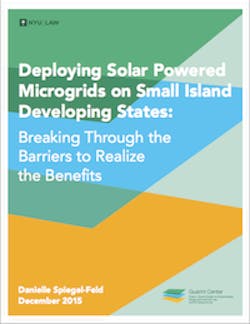Today, the majority of Small Island Developing States (SIDS) rely on imported diesel fuel to generate electricity on the islands. This reliance on diesel exposes SIDS to multiple challenges. First, the fuel must typically be transported great distances at great expense and the resulting electricity tariffs can be staggeringly high. In 2010, for instance, when global oil prices were higher than they are today, some Pacific SIDS reported tariffs above $1.00 per kilowatt-hour2—roughly 10 times the average price in the United States.3
SIDS’s reliance on diesel presents serious energy security consequences as well: when oil prices spike, SIDS’s utilities can find themselves unable to afford the fuel needed to keep their generators running4 and severe weather events can make it impossible to deliver fuel. Finally, as part of their efforts to demonstrate leadership in international climate negotiations, many SIDS have set ambitious renewable energy targets that are at odds with their continued use of diesel.5
Solar powered microgrids appear to offer a significant opportunity for SIDS to lower their electricity costs and improve their energy security, while also advancing their climate objectives. The cost of solar photovoltaic (PV) installations has fallen dramatically in recent years.6 The costs of battery storage systems, which make it possible to integrate high penetrations of PV without jeopardizing reliability, have dropped significantly too.7 In light of this progress, and the extremely high cost of fossil generation on SIDS, the case for transitioning to solar power should be clear.
